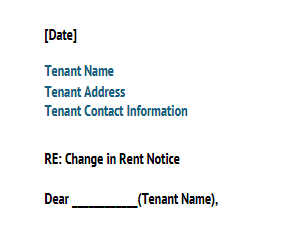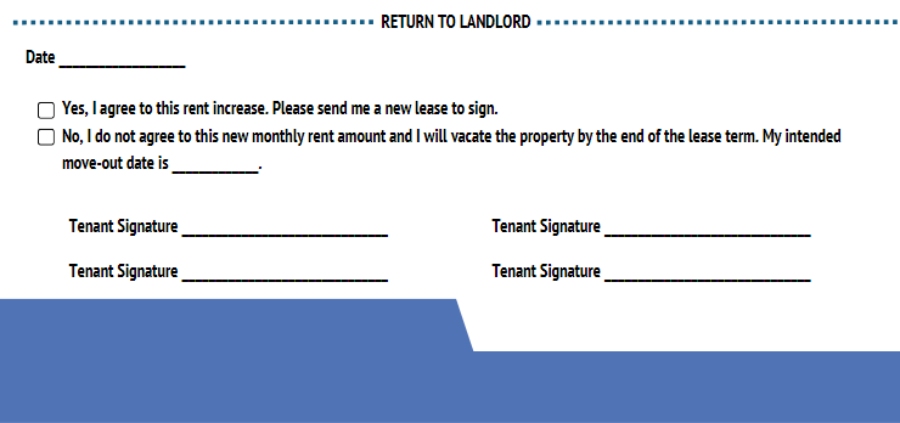While raising the rent price at your properties periodically is often necessary to make the most of your investment, informing your tenants can be difficult. All landlords need a professional and friendly rent increase letter template they can use to make rent changes. The letter should include all pertinent information like contact information, price changes, and tenant acceptance confirmations, and must also follow state laws and requirements.
We’ve created a letter template below for your convenience. Download a copy for free through Canva and customize it to your tenants’ needs.
6 Items to Include in a Rent Increase Letter
A letter of rent increase must include specific information to ensure it is clear, easy to understand, and abides by all legal requirements. Although the dates they must be sent will vary based on your rental agreement terms with the tenant, they should include the same general components, which include the following:
- Landlord name and contact information
- Date the letter is written
- Tenant’s name
- Property address
- Date the rent increase will take effect
- Amount of rent increase
- Current rental amount
- Return receipt with tenant decision of rent increase
Our rent increase letter template includes all of these components and is generally divided into the following six sections:
1. Landlord or Property Management Contact Information
At the top of your rent increase notice letter, include your name (if you are the landlord) or the property management company’s name. This asserts professionalism and helps the tenant immediately see who the letter is from, grabbing their attention better than blank papers or envelopes. Don’t forget to include a contact phone number, address, and email address if the tenant needs to contact you to discuss the increase.

Heading of rent increase letter
2. Today’s Date
When you’re increasing the rent price for your tenants, it’s important to give them plenty of notice. The primary reason for this is to foster a positive relationship between you and your tenants, but many states also have legal requirements about the amount of notice a tenant must receive on a rent increase.
In New York, landlords must give tenants with a yearly lease a 60-day notice, but only 30 days is required in Idaho. Therefore, adding the date shows that you are adhering to these laws and making this adjustment as easy for the tenants as possible.
To see the rent increase laws and regulations in your state, jump to our section on “Legal Factors to Consider”.
3. Greeting
This is an area that’s small in size but can have a major impact on how the tenant will perceive and respond to your rent increase letter. Some landlords greet their tenants by saying, “Dear tenant,” but we recommend using the tenant’s first name. Using their name feels much more personal and encourages open communication, while using a generic heading can feel robotic and impersonal.

Subject line written above the greeting
Another option is to include a subject line above the greeting, which our rental increase notice sample above includes. Even though this isn’t necessary, it’s another key strategy to get the tenant’s full attention and communicate the importance of this notice. A strong subject line is “change in rent notice,” which accurately reflects the letter’s topic without creating strong emotions. For example, the title “Notice of Increase in Rent” or “Rent Increase Notice” may immediately put tenants on the defensive and create negative emotions.
4. Body of the Letter
The body of the rent increase notice is where you have the most room for flexibility in your tone. You can be strictly professional or somewhat informal in your language based on your style and relationship with tenants. You may also choose to write a few paragraphs or keep it concise.
However you choose to write your rent increase letter to tenants, there are a few details you must include, like the following:
- Current amount of rent
- Amount of rent increase
- The date the rent increase will take effect
- Rental property address
- Notice of other terms of tenancy that are changing or remaining the same
- Details about price increase implementation

Body text of increase letter
Consider adding a phrase or paragraph expressing gratitude for the tenant’s cooperation and offering a point of contact for inquiries. Include logistical information on how to submit rent payments if the process is changing, as well as the amount and due date (e.g., “the monthly rent will be increased to $__ per month, payable in advance on/or before the 1st of each month during your tenancy”). If specific payment methods are required, such as check, cash, card, or an online system, include them in the letter.
Depending on your rent collection system in place, the rent increase may require tenants to make changes with their bank. In this case, it’s important to be clear about the expectations so they can take the necessary steps.

Seamlessly integrate Baselane Banking or your existing bank accounts (Source: Baselane)
Online rent payment services allow you to change the settings digitally without asking for any further activity from the tenant. For example, with Baselane, all rent payments and reminders are automated for tenants and owners, streamlining transactions. Additionally, paying taxes and managing rentals is quick and easy, thanks to the platform’s range of tools. If you’re looking for an efficient way to manage your rentals, consider using Baselane.
5. Closing Line & Signature
The final line of the rental increase letter should be short, professional, and friendly. Keep it simple and use a phrase like “Sincerely,” “Thank You,” or “All the best.” Below the closing line, add your name, a space for your signature, and your title (e.g., “landlord” or “property manager”) to make it a proper formal letter.
6. Tenant Rent Increase Decision
At the bottom of your rent letter for the tenant, include a tear-off section for the tenant to sign and return to you. It should have a space for them to write the date and multiple options for their response. For example, if they agree to the rent increase, you can include the next steps, like, “I agree to this rent increase. Please send me a new lease to sign.”
On the other hand, if they disagree with the rent increase, you can provide options for them to check. In most cases, refusing the rent increase will force them to leave the property, so you can include the necessary information for this choice.

Tenant acceptance or rejection of rent increase
Some landlords ask for a response from tenants differently, like through email or phone. However, these methods tend to have more obstacles, like delivery issues and miscommunication. Including a physical section on the letter removes potential barriers and provides documentation that proves the tenant received the landlord’s increase rent letter, acknowledged their options, and agreed to the next steps.
Reasons to Send a Rent Increase Letter
Landlords generally send an increase rent letter to tenants for the following reasons:
- Cover carrying costs or increase cash flow: If your expenses have risen significantly, it’s necessary to raise rent to maintain positive cash flow.
- Generate higher return on investment (ROI): Upon conducting a rental market analysis (RMA), some first-time rental property owners may find that they have priced their property lower than the competition. Raising rent to align with market rates can boost your property’s ROI.
- Negotiate lease renewal: During rental seasons, when demand is low, landlords can offer tenants a deal with a minimal increase in rent. This strategy can effectively encourage tenants to stay longer, which helps landlords maintain a steady cash flow and reduces the risk of extended vacancies once the lease expires.
- Retain great tenants: Offer smaller rent increases to encourage good tenants to stay, enhancing your property’s long-term success.
- Dissuade lease renewal: If you do not want the tenant to renew the lease, consider raising the rent to a higher price.
- Tenant inheritance: When purchasing a property with existing tenants, a rent increase may be necessary to align with your financial goals.
Pro tip: Raising the rent can be a useful strategy to prompt undesirable tenants to vacate, but the most effective approach is to prevent bad tenants by conducting thorough initial applicant screening. Utilize tools for comprehensive tenant screening, including credit, criminal, and eviction checks, to ensure you choose the right tenants from the start.
Legal Factors to Consider When Increasing Rent
Landlord-tenant laws vary across states and outline specific requirements for both parties involved. As a responsible landlord, ensure you stay informed and adhere to these laws and regulations, including rent increase guidelines and notice periods.
Rent control regulations exist in some states to limit how much landlords can increase their rental prices. In California, for example, annual rent increases cannot exceed 5% plus a maximum cost-of-living adjustment of 5% (maximum increase of 10%). However, no regulations exist to set the original rental price for new tenants. As a landlord, you must learn how much to charge for rent from the beginning of your investment journey.
Rent increases apply to both month-to-month and longer-term tenants, but notice requirements vary based on the type of lease. As mentioned, Idaho requires a 30-day notice, while Delaware and Vermont require a 60-day notice. Find your state on the map below to learn more about your state’s specific regulations on notice periods.
When & How to Send a Letter to Increase Rent
After reviewing your state’s regulations to certify you’re in compliance, you can decide when and how you’ll send your increase letter. While raising rent is typically done when a new tenant arrives or when a lease ends, you can send a rent increase letter at four different times:
- The end of an annual lease
- Prior to a lease renewal
- At the end of a month-to-month lease
- During the middle of a lease (only legal if there is a clause in the lease that allows it)
Most leases do not automatically renew. In these cases, you and your tenants must sign a new lease with updated terms and pricing before the original one expires. Rent increases usually take effect with the first payment after the notice period. Therefore, the date and delivery method of the notice are crucial. A rent increase letter is a formal document and requires careful delivery. These are the three primary delivery options:
- Certified mail: This is the preferred method as it provides a documented record of sending and receipt, preventing disputes over notice receipt or timing. Include the date and send it well in advance to ensure it arrives within the required notice period. For instance, send it at least five days before a 60-day notice to avoid timing issues.
- Email: This is an acceptable method, but it can be challenging to prove tenant receipt. Tracking tools can help indicate when an email is opened, but relying on software for legal tasks can be risky. Instead, you can manually request a read receipt through your email platform.
- In-person delivery: This is another acceptable method, but proving tenant receipt can also be challenging. Personal delivery lacks documentation, so consider asking for a signed acknowledgment of receipt from the tenant.
Documenting your transactions and communication with tenants is essential for fulfilling your financial and administrative duties as a landlord. To foster a transparent and positive relationship with tenants, consider providing them with documentation and a free downloadable rent receipt template.
Frequently Asked Questions (FAQs)
Yes, negotiating a rent increase with a tenant is possible. Approach the negotiation with professionalism and transparency. Start by understanding the tenant’s perspective and reasons for potentially not wanting to pay the increased rent. Then, explain your reasons for the increase and any costs you may be facing as a landlord. From there, work together to find a solution that works for both parties. Remember to document any changes to the rental agreement in writing and to follow state laws and regulations regarding rent increases.
While there is no federal law that sets a limit on how much rent can be raised, some states and cities have their own laws and regulations regarding rent increases. In certain areas, landlords must provide a specified amount of notice before raising rent, and some areas have rent control laws that limit how much rent can be increased annually. It’s crucial for landlords to conduct research and comply with the laws and regulations in their particular area to avoid any legal issues.
When faced with a tenant’s decision to move out due to a rent increase, it’s crucial to act quickly and systematically. Start by documenting their choice in writing and dispatching any mandatory notices, such as a notice to vacate. Process and return their security deposit, ensuring you deduct any outstanding rent or valid property damages. To avoid prolonged vacancy, promptly advertise the property and reevaluate the proposed rent in light of current market conditions. As you transition, be ready with a fresh lease and thorough screening procedures for potential new tenants. For smooth navigation, consider seeking advice from a local attorney or property manager to ensure you’re in line with local regulations.
Bottom Line
One of the difficult and exciting elements of investing in real estate is the ability to set prices independently and be in control of your income. By using the tips above, sending a rent increase notice can be simple and efficient—helping you generate a higher income from your rental property. Make sure to research the landlord-tenant laws in your state and include the right information in your letter.
